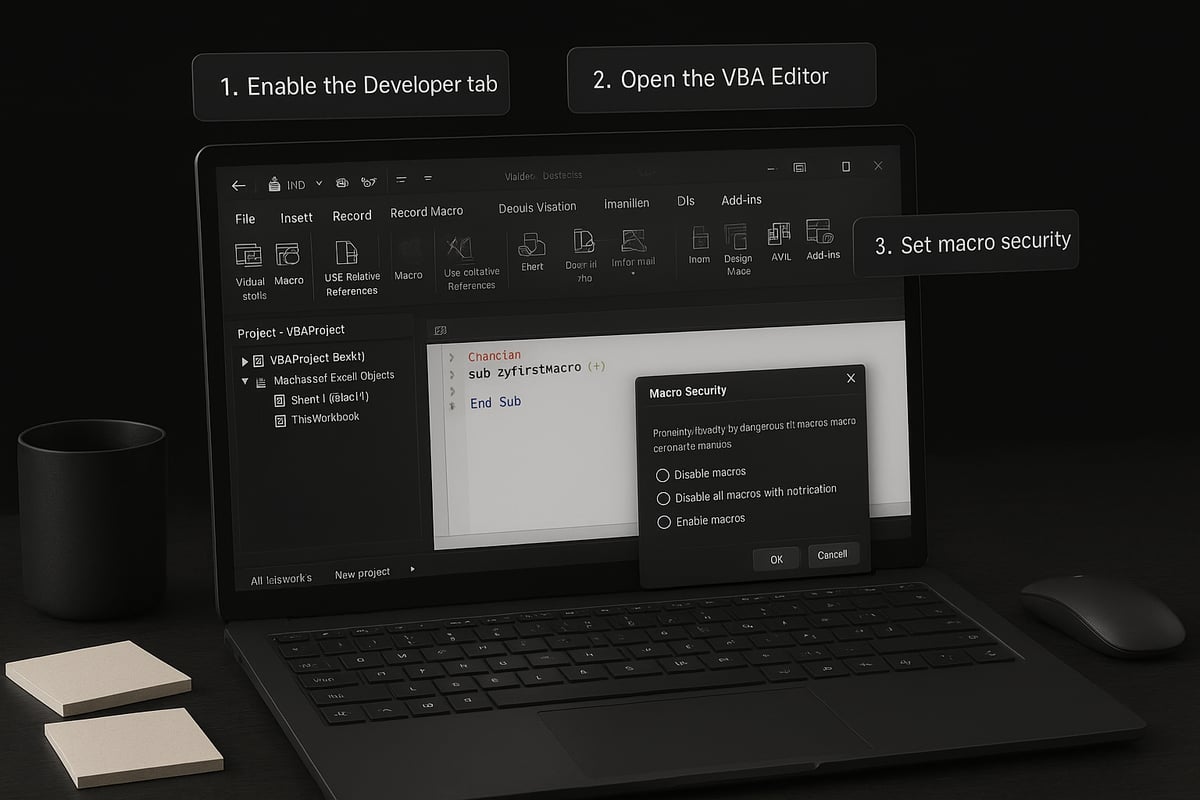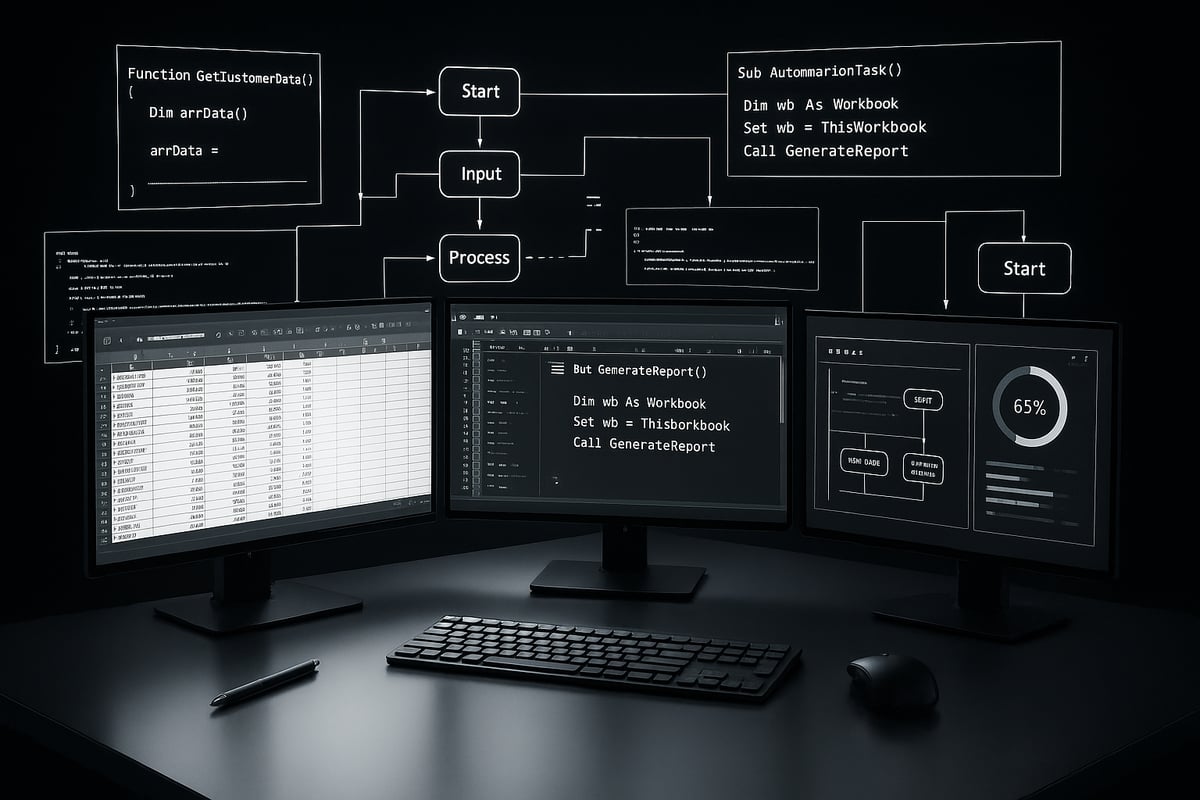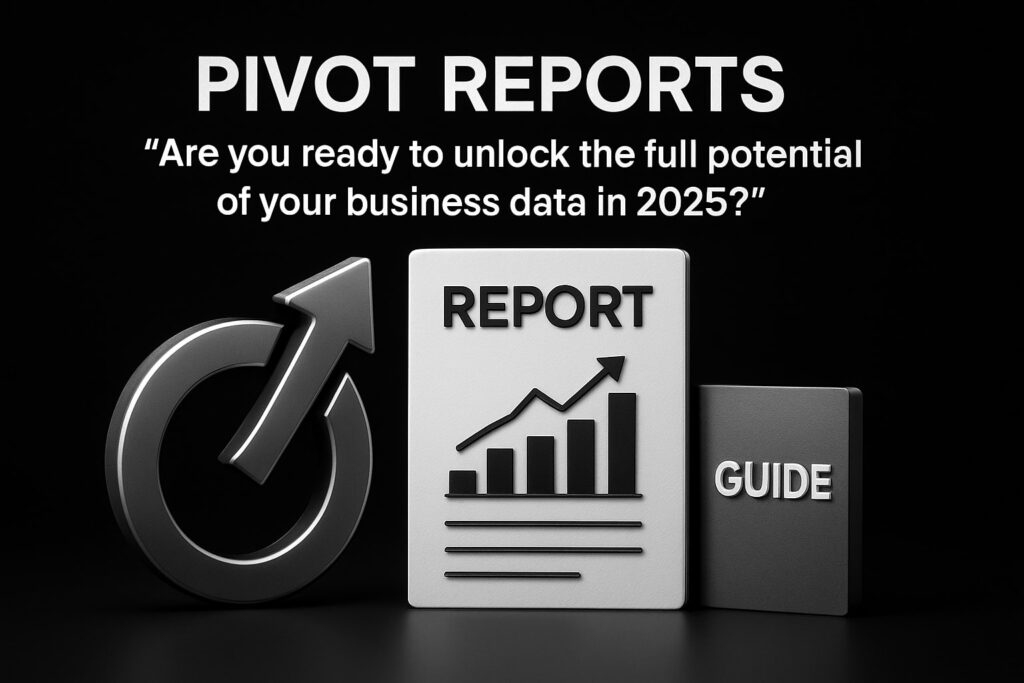Are you ready to transform the way you work with data? In 2025, excel vba excel is setting a new standard for business automation and streamlined management.
This guide gives you the tools to master automation, helping you unlock greater efficiency and productivity. Imagine automating tedious tasks and focusing on what really matters.
You will explore VBA fundamentals, practical automation strategies, advanced coding techniques, real-world applications, and the latest trends. Discover the power of VBA, build your expertise, and take action with our step-by-step guidance.
Understanding Excel VBA: Foundations for Automation
Excel VBA Excel is the backbone of powerful automation in the modern spreadsheet environment. With businesses in 2025 demanding ever-greater speed and efficiency, understanding excel vba excel is essential for professionals seeking to streamline repetitive tasks, manage data, and unlock new productivity levels.
What is Excel VBA?
Excel VBA Excel stands for Visual Basic for Applications, a programming language built into Excel. It enables users to write instructions that automate tasks, manipulate data, and interact with Excel’s features far beyond what formulas alone can achieve. While many users are familiar with simple macros, excel vba excel opens the door to true customization and automation.
VBA vs. Macros: How Do They Differ?
| Feature | Macros (Recorded) | Excel VBA Excel (Written) |
|---|---|---|
| Creation | Click-and-record | Manual coding |
| Flexibility | Basic tasks | Advanced logic and automation |
| Editing | Limited | Fully customizable |
| Error Handling | Minimal | Robust options |
Macros are quick recordings of actions, but excel vba excel lets you write and edit code for more complex solutions. Both work together, as recorded macros generate VBA code that can be further refined.
Core Components of Excel VBA
To master excel vba excel, it’s vital to know the building blocks:
- Modules: Containers for your code.
- Procedures: Subroutines (
Sub) and functions (Function) that perform tasks. - Variables: Store data for calculations and logic.
- Objects: Elements like Workbooks, Worksheets, and Ranges.
Each component allows you to structure your automation logically, making your code readable and reusable.
How Excel VBA Interacts with Excel’s Object Model
Excel vba excel operates by controlling the Excel Object Model. This model is a hierarchy of objects, such as:
- Application: The Excel program itself.
- Workbook: Each open file.
- Worksheet: Individual sheets in a workbook.
- Range: Cells or groups of cells.
By referencing these objects, you can automate tasks like moving data between sheets, formatting ranges, or generating reports. For instance, instead of manually copying data, excel vba excel code can do it instantly with a single command.
Navigating the VBA Editor and Ensuring Security
Accessing the VBA Editor is straightforward. Simply press Alt + F11 in Excel to open the workspace. The editor displays your projects, modules, and code windows, making it easy to organize and debug your excel vba excel scripts.
Security is crucial. Macros can contain harmful code, so always adjust macro settings in Excel’s Trust Center. Use trusted locations for storing workbooks with VBA. Regularly review permissions and avoid enabling macros from unknown sources to keep your data safe.
A Simple Excel VBA Macro in Action
Let’s look at how excel vba excel can automate a repetitive task, such as formatting a data range:
Sub FormatSalesData()
With Worksheets("Sales").Range("A1:D100")
.Font.Bold = True
.Interior.Color = RGB(220, 230, 241)
End With
End Sub
This macro instantly formats a table in the "Sales" sheet, saving time and ensuring consistency. Over 70% of Excel power users automate at least one workflow with VBA, according to a 2024 industry survey.
Mastering excel vba excel is foundational for automating complex processes and future-proofing your skills. For those ready to explore more, Excel help for business automation provides additional guidance on leveraging VBA to optimize business operations.
Setting Up for Success: Preparing Excel for VBA Automation
Preparing your workspace is the first step toward mastering excel vba excel automation. A smooth setup ensures you can focus on building time-saving solutions without interruptions. Let’s walk through the essentials to get you started confidently.
Enabling and Configuring VBA
To begin automating with excel vba excel, you must enable the Developer tab in Excel 2025. This tab houses the tools needed to access VBA features.
Step-by-step:
- Open Excel and go to
File>Options. - Click
Customize Ribbon. - Check the box for
Developerin the right pane. - Click
OKto display the Developer tab.
Next, adjust macro security for safe automation. Go to the Developer tab and select Macro Security. Choose either Disable all macros with notification or Enable macros for trusted documents. Only enable macros from trusted sources to protect your data.
Trusted access is also crucial. Save files in trusted locations by adding folders in Trusted Locations under macro security settings. This reduces warning prompts when opening files with macros.
Common pitfalls include not seeing the Developer tab or missing macro options. Double-check Excel options and ensure you have the correct version. If you run into persistent issues or need advanced help, consider Custom Excel programming and spreadsheet help for expert guidance.
Troubleshooting tip: Restart Excel after changing settings to apply updates. Setting up excel vba excel correctly from the start saves time and avoids frustration later.
Navigating the VBA Editor
Once excel vba excel is enabled, open the VBA Editor by clicking Visual Basic on the Developer tab or pressing Alt + F11. The VBA Editor is your workspace for writing and managing automation code.
Key windows include:
- Project Explorer: Displays all open workbooks and their VBA modules.
- Properties Window: Shows properties for selected objects.
- Code Window: Where you write and edit code.
Organize your workspace by docking or undocking these windows as needed. Customize the environment by adjusting font size and color schemes under Tools > Options.
Boost productivity using bookmarks to mark code sections and breakpoints to pause code during debugging. The Immediate window is handy for testing commands instantly.
To navigate to a specific module, double-click its name in the Project Explorer. This opens the code window for editing. Getting comfortable with these tools makes working with excel vba excel more efficient and enjoyable.
Writing Your First Macro
With your excel vba excel environment ready, you can automate your first task. Decide whether to record a macro or write one from scratch. Recording is quick and requires no coding, while writing gives you more control.
Recording a macro:
- Go to the Developer tab and click
Record Macro. - Name your macro and assign a shortcut if desired.
- Perform the actions you want to automate, then click
Stop Recording.
Writing a simple macro:
Sub FormatHeader()
Range("A1:D1").Font.Bold = True
Range("A1:D1").Interior.Color = RGB(200, 200, 255)
End Sub
Save your macro, then run it from the Developer tab. This small step introduces you to the power of excel vba excel automation.
Core Automation Techniques in Excel VBA
Unlocking automation potential in Excel begins with mastering foundational techniques. By leveraging excel vba excel, professionals can streamline repetitive tasks, boost accuracy, and save valuable time. Below, we explore the essential methods that power efficient automation in today’s dynamic business landscape.
Working with Ranges, Worksheets, and Workbooks
In excel vba excel, referencing cells, ranges, and sheets efficiently is crucial for robust automation. Rather than relying on .Select or .Activate, which slow down execution and clutter your code, use direct references. For example, instead of selecting a range before copying, assign it to a variable and perform actions directly.
Reference Types in VBA
| Reference Type | Syntax Example | Use Case |
|---|---|---|
| Cell | Range("A1") |
Single cell reference |
| Range | Range("A1:B10") |
Multiple cells |
| Worksheet | Worksheets("Sheet1") |
Target a specific sheet |
| Workbook | Workbooks("Report.xlsx") |
Work with different files |
To copy data between sheets without selecting:
Worksheets("Sheet2").Range("A1:A10").Value = Worksheets("Sheet1").Range("A1:A10").Value
Avoiding .Select can make your excel vba excel code up to 30% faster, according to community consensus. Variables further enhance reusability, allowing you to automate across different ranges or sheets by changing only a few lines.
Automating Tasks with Loops and Conditions
Automation in excel vba excel often relies on loops and conditional logic. The For, For Each, and Do loops process data in bulk, while If...Then...Else statements enable dynamic decision-making. For example, you might loop through rows to apply conditional formatting or filter data.
A typical row-processing loop looks like this:
Dim ws As Worksheet
Set ws = Worksheets("Data")
Dim i As Long
For i = 2 To ws.Cells(ws.Rows.Count, 1).End(xlUp).Row
If ws.Cells(i, 2).Value > 100 Then
ws.Cells(i, 2).Interior.Color = vbGreen
End If
Next i
Error handling is essential for stable excel vba excel automation. Use On Error Resume Next for simple cases, or structured error trapping for more complex scenarios. If you encounter persistent issues, consult Excel troubleshooting tips and solutions for practical debugging guidance.
User Interaction and Input
Interactivity elevates excel vba excel scripts, making them responsive to user needs. Message boxes (MsgBox) display information or alerts, while input boxes (InputBox) collect user data. Always validate inputs to prevent errors and ensure smooth automation.
For instance, prompting for a report date:
Dim reportDate As String
reportDate = InputBox("Enter the report date (YYYY-MM-DD):")
If IsDate(reportDate) Then
MsgBox "Generating report for " & reportDate
Else
MsgBox "Invalid date. Please try again.", vbExclamation
End If
By integrating these interactive elements, your excel vba excel automations become not only powerful but also user-friendly. Well-designed prompts and validations keep workflows efficient and error-free, allowing even non-technical users to benefit from automation.
Advanced VBA Automation Strategies for 2025
Excel VBA Excel has evolved into a robust platform for business automation. As organizations demand faster, smarter solutions, mastering advanced strategies is essential. This section explores powerful automation techniques that will keep your skills ahead of the curve in 2025.
Integrating with External Data Sources
Connecting Excel VBA Excel to external data sources unlocks new automation possibilities. You can link workbooks to SQL databases, Access files, or cloud APIs, enabling real-time data exchange and streamlined workflows.
To automate data imports, use objects like ADODB.Connection for database access or XMLHttpRequest for web APIs. For example, automating monthly report imports from a database can eliminate manual copy-paste and reduce errors.
Sub ImportDataFromSQL()
Dim conn As Object
Set conn = CreateObject("ADODB.Connection")
conn.Open "Provider=SQLOLEDB;Data Source=SERVER;Initial Catalog=DB;User ID=USER;Password=PWD;"
' Add code to retrieve and paste data
conn.Close
End Sub
Security is crucial. Always store credentials securely, use trusted locations, and restrict macro permissions to minimize risk.
Importing and exporting data via CSV or XML is also common. Automate these routines to ensure consistency and speed.
AI tools are increasingly part of Excel VBA Excel workflows. For a deeper look at combining automation with artificial intelligence, see the AI-Powered Excel VBA Automation Guide 2025.
Key tips:
- Validate imported data before processing.
- Use parameterized queries for database security.
- Document all external connections for transparency.
Event-Driven Programming and Custom Functions
Event-driven programming in Excel VBA Excel allows your code to respond automatically to user actions or worksheet changes. By leveraging workbook and worksheet events, you can create dynamic solutions that update dashboards, track changes, or trigger alerts without manual intervention.
For example, the Worksheet_Change event runs code whenever a cell is edited:
Private Sub Worksheet_Change(ByVal Target As Range)
If Target.Column = 2 Then
MsgBox "Data updated in Column B"
End If
End Sub
Custom functions, or User Defined Functions (UDFs), expand Excel’s calculation power. You can create specialized formulas for complex business logic, which are then accessible like built-in functions.
Key best practices for event-driven automation:
- Keep event procedures efficient to avoid slowing down your Excel VBA Excel environment.
- Use flags or checks to prevent infinite loops.
- Document triggers and expected behaviors for each event.
By combining these techniques, you create responsive, intelligent automation that adapts to user needs and business changes.
Debugging, Testing, and Optimizing VBA Code
Effective debugging is essential for reliable Excel VBA Excel automation. The VBA Editor offers robust tools, including breakpoints, watches, and the Immediate window, to inspect variables and step through code.
For example, set a breakpoint by clicking the margin beside a code line. Use Debug.Print to output values to the Immediate window and monitor program flow.
Performance optimization is a constant priority. Avoid repetitive actions, minimize worksheet interactions, and replace .Select or .Activate with direct object referencing. Refactoring large macros into modular procedures simplifies testing and maintenance.
A table summarizing common performance tips:
| Issue | Solution |
|---|---|
| Slow loops | Use arrays for bulk actions |
| Excessive screen updates | Disable with Application.ScreenUpdating = False |
| Unnecessary selections | Directly reference objects |
Testing in controlled environments helps catch edge cases early. Always back up workbooks before deploying changes to production.
By refining your Excel VBA Excel code with these strategies, you ensure automation solutions are robust, efficient, and ready for future demands.
Real-World Automation Use Cases and Best Practices
Excel VBA Excel is at the heart of modern business automation, driving efficiency and accuracy in daily operations. Professionals across industries rely on VBA to streamline tasks that once consumed countless hours, empowering teams to focus on strategic goals.
Automating Financial Reporting
One of the most impactful Excel VBA Excel applications is automating financial reporting. Teams can consolidate monthly data from multiple departments with a single macro, reducing manual copy-paste errors. Automating these workflows not only saves time but also ensures consistency in report formats and calculations.
For example, a VBA script can loop through department workbooks, extract key figures, and compile them into a central summary sheet. This approach eliminates repetitive work and supports faster decision-making.
Streamlining Data Cleaning
Data cleaning is essential for reliable analysis. Excel VBA Excel excels at removing duplicates, standardizing formats, and validating entries. With a well-designed macro, you can automate the entire cleaning process for large datasets.
A typical macro may scan rows for duplicate entries, correct inconsistent date formats, and flag anomalies. This reduces the risk of errors and accelerates data preparation for reporting or visualization.
Bulk Email Generation
Personalized communication is crucial in today’s business environment. Excel VBA Excel enables bulk email generation by merging spreadsheet data with email templates. This is especially useful for sending invoices, reminders, or newsletters to clients.
By linking Excel to Outlook, a VBA macro can automatically create and send customized emails based on recipient data. This method ensures that each message is tailored, professional, and delivered promptly.
Automating Chart and Dashboard Updates
Dynamic dashboards are essential for executive reporting. Excel VBA Excel can update charts and dashboards automatically when new data arrives. With event-driven macros, visualizations stay current without manual intervention.
For instance, a macro might refresh sales charts after importing new figures or adjust dashboard filters based on user selections. This keeps stakeholders informed with minimal effort.
Case Study: Inventory Tracking Success
A manufacturing firm implemented Excel VBA Excel to automate inventory tracking. By linking stock records across multiple sheets, the VBA solution provided real-time updates and automated reorder alerts. According to the team, this saved over 10 hours per week and reduced stockouts.
Such success stories illustrate how embracing VBA automation can lead to measurable productivity gains.
Best Practices for Effective VBA Automation
To maximize the benefits of Excel VBA Excel, follow these best practices:
| Best Practice | Description |
|---|---|
| Modular Code | Break macros into small, reusable procedures. |
| Documentation | Comment code for clarity and future updates. |
| Version Control | Save versions to track changes and rollback. |
Consistent use of these strategies ensures your automation projects are robust and maintainable.
Limitations and When to Consider Alternatives
While Excel VBA Excel is powerful, it has limitations with extremely large datasets or complex integrations. In such cases, consider tools like Power Query or Power Automate for enhanced scalability.
For more real-world examples and free templates, explore Free business process automation using Excel, which showcases practical VBA automation solutions for businesses.
Future Trends: The Evolving Role of VBA in Excel Automation
As businesses advance into 2025, the landscape of automation is shifting rapidly. Excel vba excel remains a cornerstone for professionals, even as new technologies emerge. Understanding how these trends impact automation is essential for anyone seeking to future-proof their skills.
Artificial intelligence and machine learning are making their mark in Excel vba excel automation. Excel 2025 introduces smarter features, including AI-powered data analysis and seamless Python integration. These advancements allow users to automate complex analytics and data transformations directly within Excel. For a deeper look at these innovations, see Excel’s AI Revolution and Python Integration.
Excel vba excel is also influenced by the rise of Office Scripts and Power Automate. These tools offer low-code automation and cloud connectivity. While they expand possibilities, VBA remains vital for custom workflows and legacy solutions. Many organizations use a hybrid approach, leveraging VBA for intricate tasks and Office Scripts for broader cloud-based automation.
Excel 2025 brings new scripting APIs and LAMBDA functions, empowering users to create reusable formulas and more dynamic automations. These features complement, rather than replace, the power of excel vba excel. As automation options grow, professionals should maintain strong VBA skills while exploring new tools.
Looking ahead, VBA’s relevance in enterprise environments is expected to persist throughout the decade. Its deep integration with Excel and robust community support ensure ongoing demand. To explore the enduring value of VBA, visit VBA’s Continued Relevance in 2025.
To stay updated, engage with online forums, attend webinars, and participate in community-driven events. Continuing education and hands-on experimentation will keep your excel vba excel expertise sharp as automation evolves.
Summary Table: Key Future Trends in Excel VBA Automation
| Trend | Impact on VBA Users |
|---|---|
| AI & Machine Learning | Advanced analytics, smarter automation |
| Python Integration | Extended scripting capabilities |
| Office Scripts & Power Automate | Hybrid automation solutions |
| LAMBDA Functions & APIs | More dynamic, reusable code |
| Ongoing Enterprise Relevance | Continued career opportunities |
Excel vba excel remains a vital skill for automation professionals. By embracing new trends and tools, you can ensure your automation expertise stays relevant and valuable for years to come.







